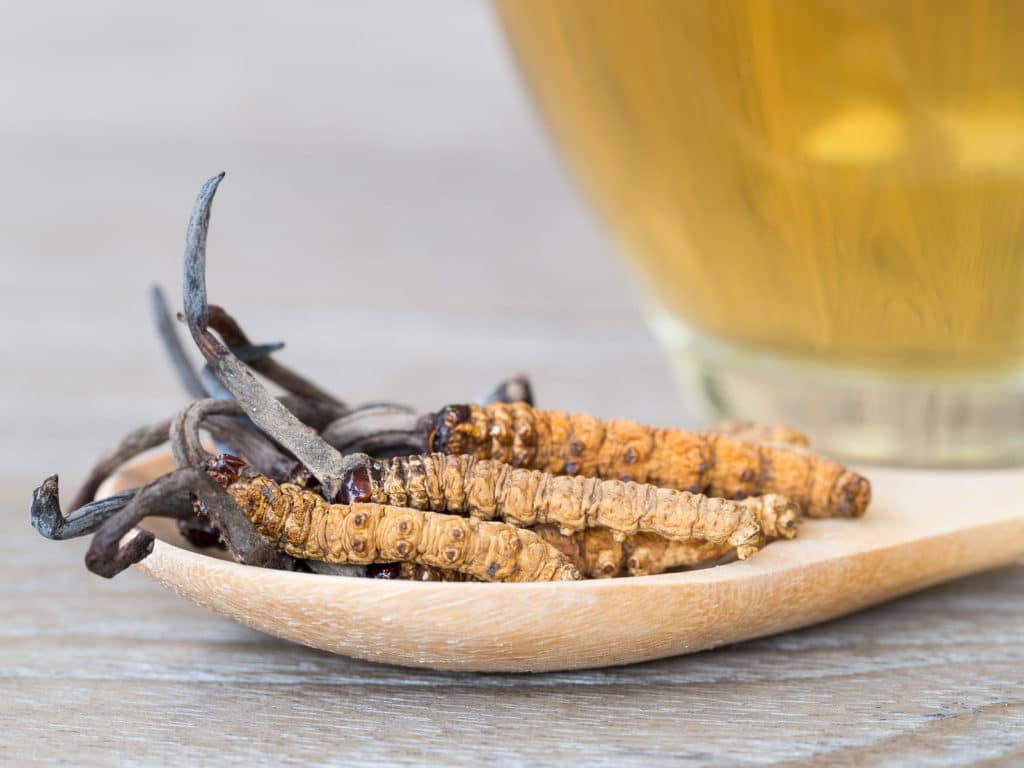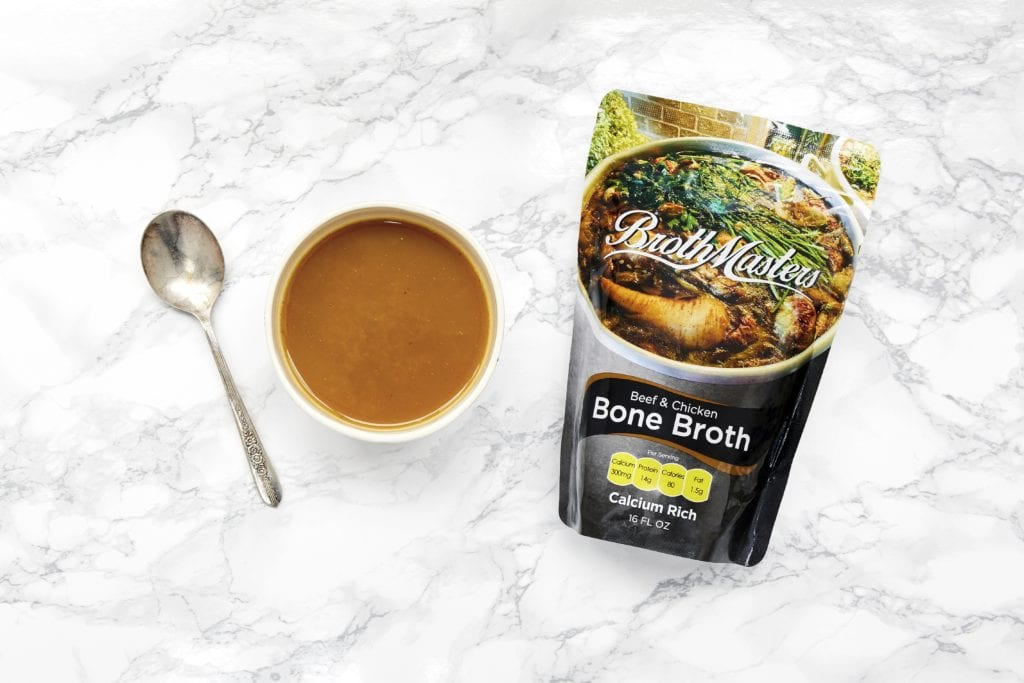What you will learn in this article:
-
What Bone Broth Is
-
How to Make Bone Broth
-
Health Benefits of Bone Broth
-
The 6 Best Ways To Make Bone Broth
-
Bone Broth Recipes To Get You Started
There’s nothing like cozying up to a warm mug of bone broth on a chilly day or when you’re feeling under the weather. The long-simmered broth has been called liquid gold, and for good reason.
To start, bone broth packs health-promoting ingredients like collagen, essential amino acids like glycine and glutamine, and potent nutrients. There’s also ample opportunity to add more nutrition, like anti-inflammatory vegetables, or medicinal mushrooms.
Here, I’ll break down everything you need to know about bone broth, share my fool-proof ways to make your broth even healthier, and provide recipes to get you started. Read on.
What Is Bone Broth, Exactly?
What sets bone broth apart from typical stock or broth? It breaks down to three things: a low-heat and long simmer (overcooking will damage the collagen cells and the broth won’t gel); the quality of the bones (grass-fed are ideal); and the collagen-rich components used, like feet and joints. A good bone broth simmers long enough to break down connective tissues and nutrients from the bones. Typical broth or stock, on the other hand, boils only long enough to extract flavor, and not as many health-promoting gelatin and collagen, among other nutrients.
Don’t fret, though: Bone broth is delicious, and can be made mild enough to blend into something unnoticeable for a nutrient boost, or rich and densely flavored enough for a hearty soup or stew. You can make bone broth from cattle bones, chicken bones, even fish bones.
Let’s break down some of the many health benefits of bone broth, and all the ways you can make it to suit your health needs.
The Benefits of Bone Broth
Bone broth is rich in collagen
Perhaps the biggest reason people turn to bone broth is its impressive collagen content. Collagen makes up nearly one-third of our total protein, found mostly in our skin, tendons, cartilage, and bone. It literally holds us together, and bone broth keeps that collagen strong.
Bone broth is packed with important amino acids
Not only is bone broth rich in collagen, it’s also composed of key amino acids like glycine, proline, and glutamine. Glycine acts as a neurotransmitter in our brains, while proline plays an important role in protein synthesis, metabolism, wound healing, immune response, and more. Glutamine fuels your intestinal health and immune system.
Bone broth is good for your hair, skin, and nail
Since bone broth is so rich in collagen, it’s great for taking care of your hair, skin, and nails, all of which rely on ample collagen to stay healthy.
Bone broth can help heal your gut
Bone broth contains two ket nutrients that work directly on your intestinal epithelial lining: glutamine and gelatin. These help combat “leaky gut,” a condition tied to autoimmune issues, asthma, food allergies, and more.
Bone broth may help you sleep better
Glycine, an amino acid found in bone broth, has been found to improve sleep quality in those suffering from insomnia. It also helps improve daytime sleepiness and mental fog.
Bone broth helps keep your brain healthy
Glycine improves sleep hygiene, which in turn improves your brain health. Bone broth can also help keep you more alert and cognitively sharp.
Bone broth helps ease joint pain
If you suffer from joint pain, the collagen content of bone broth can help combat it.
6 Ways to Make Your Bone Broth Healthier
1. Add Hormone-Balancing Herbs and Spices
Bone broth can be tweaked to fit your health needs, and there are plenty of hormone-balancing herbs and spices that add flavor and healing to your broth. Try turmeric for a boost of warm, spiced flavor and a healthy dose of anti-inflammatory effects. Same with ginger – you can also add peppercorn to that mixture for a potent antioxidant effect.
If stress is the issue, try adaptogenic herbs like ashwagandha or stress-fighting astragalus. Ashwagandha has a slight bitter flavor that’s well-masked by the flavor of the meat bones you use, while astragalus is pleasant, earthy, and complementary.
To recap, here are a few herbs and spices you can try in your bone broth, though there are many more options to choose from:
· Astragalus (to calm constant stress)
· Ashwagandha (to de-stress and support adrenals)
· Turmeric (to fight inflammation)
· Ginger (to fight inflammation)
· Peppercorn (an antioxidant)
2. Simmer Low and Slow
Bone broth is a labor of love, and is not a dish you cook up quickly. The meat bones you choose must cook down low and slow to extract collagen, gelatin, and all those healing amino acids.
For chicken bone broth, cook your bones for a max of 24 hours. Larger animals like cows and lamb are sturdier and can cook for up to 48 hours. For delicate fish bones, we recommend no more than 4 hours. Feel free to use a slow cooker to minimize the risk of an open flame. You’ll know you’ve brewed a good bone broth when it turns gelatinous in the fridge.
If you’re short on time, you can use the Instant Pot. Pressure cook your chicken bone broth for three hours, and your beef bone broth for four. Fish bone broth should only take 45 minutes to an hour in the Instant Pot.
3. Add Medicinal Mushrooms
Medicinal mushrooms like reishi, cordyceps, and chaga add deep, earthy flavor to a bone broth, in addition to a host of health effects. Stick to one medicinal mushroom, or a complementary blend, at a time when cooking them in a bone broth, of course.
Reishi mushrooms have been found to combat anxiety and depression and boost immunity, and that’s just a small sample of their capabilities. This powerful mushroom is commonly consumed as a powder, and while you can definitely add that powder to your broth to make a warm elixir, you can also add whole dried reishi mushrooms to your simmer.
Chaga is a potent antioxidant and has anti-inflammatory effects. It is also commonly sold in powder form, but go ahead and throw whole dried chaga in your simmer if you can get your hands on some.
Cordyceps are wonderful if you’re trying to break a caffeine habit – there’s no better way than to replace your morning coffee with a warm mug of cordyceps-infused bone broth. It may also be helpful for autoimmune thyroid conditions and fighting inflammation.

4. Add Kelp and Kombu
Need to add some iodine to your diet? A healthy, food-based source includes sea vegetables like kelp and kombu. Iodine helps support your thyroid, and food-based sources are one of the easiest ways to get it in your body.
More than that, both kelp and kombu offer a rich, earthy flavor that adds tons of depth to any bone broth you cook up.
5. Infuse Your Bone Broth with Anti-Inflammatory Vegetables
This may sound self-explanatory, but a healthy dose of anti-inflammatory vegetables never hurt anything. In the case of bone broth, vegetables not only add flavor, but tons of nutrition. Anything that you think pairs well with the bones you’re cooking will work. In fact, bone broth is an excellent way to use up vegetable scraps from earlier cooking endeavors (onion peels, carrot tops, celery trimmings, etc.)
Here’s a few vegetables to try:
- Celery
- Carrots
- Onion
- Garlic
- Shallots
- Leeks
6. Add Apple Cider Vinegar
If you’ve previously had bone broths that carried more funk than you’d prefer, there’s an easy fix. Apple cider vinegar helps leach out more nutrients from the marrow within the bones, as well as break down more of the tissues during the cooking process. It also fights that funky earthiness, with a touch of sweetness and tang.
Not to mention, apple cider is rife with health benefits. It helps lower blood sugar and fight Type 2 diabetes, and can even help you lose weight.
Bone Broth Recipes to Get You Started
Below, you’ll find recipes for both chicken and beef broths, whose long simmers place them firmly into bone broth territory. Use these bone broths up to delicious effect in the remaining recipes.
Beef Stock for the Thyroid Diet
Classic Chicken Broth
Easy Miso Soup
Brown Lentil Stew
Apple Squash Soup with Coconut Butter
Instant Pot Bison and Cabbage Stew
Instant Pot Chicken Rice Soup
You can make your own bone broth to use in these recipes, of course. But, if you don’t have access to grass-fed bones or the time to make the broth yourself, I recommend using BrothMasters bone broth. The mother-daughter duo behind BrothMasters slow simmers their broths for a full 48 hours, avoiding high heat that could destroy the nutrients in the bones and vegetables they use, but keeping temperatures high enough to be safe. The Hormones Balance team and I are big fans of their broth — unlike other brands that can be a bit bland, BrothMasters offers rich, hearty broths that are full of flavor. I like to heat a few cups and sip on it as an easy, healthy snack. Click here to get BrothMasters bone broth and use code “HBGIFT” to get $15 off your order.
Whip up our Instant Pot bison and cabbage stew with BrothMasters beef and chicken broth, or make a healing mug of chicken rice soup with their cozy broth.
Resources:
Britannica, The Editors of Encyclopaedia. “Collagen.” Encyclopædia Britannica, Encyclopædia Britannica, Inc.
Wu, Guoyao, et al. “Proline and Hydroxyproline Metabolism: Implications for Animal and Human Nutrition.” Amino Acids, U.S. National Library of Medicine, Apr. 2011.
Hernandes, Marina Sorrentino, and Lanfranco R P Troncone. “Glycine as a Neurotransmitter in the Forebrain: a Short Review.” Journal of Neural Transmission (Vienna, Austria : 1996), U.S. National Library of Medicine, Dec. 2009.
Gundersen, R Y, et al. “Glycine–an Important Neurotransmitter and Cytoprotective Agent.” Acta Anaesthesiologica Scandinavica, U.S. National Library of Medicine, Sept. 2005.
Kim, Hyeyoung. “Glutamine as an Immunonutrient.” Yonsei Medical Journal, Yonsei University College of Medicine, Nov. 2011.
Yamadera, Wataru, et al. “Glycine Ingestion Improves Subjective Sleep Quality in Human Volunteers, Correlating with Polysomnographic Changes.” Wiley Online Library, John Wiley & Sons, Ltd (10.1111), 27 Mar. 2007.
Bannai, Makoto, et al. “The Effects of Glycine on Subjective Daytime Performance in Partially Sleep-Restricted Healthy Volunteers.” Frontiers in Neurology, Frontiers Research Foundation, 18 Apr. 2012.
Zdzieblik, Denise, et al. “Improvement of Activity-Related Knee Joint Discomfort Following Supplementation of Specific Collagen Peptides.” Applied Physiology, Nutrition, and Metabolism, U.S. National Library of Medicine, June 2017.
Park, Hyun-Jung, et al. “The Effects of Astragalus Membranaceus on Repeated Restraint Stress-Induced Biochemical and Behavioral Responses.” The Korean Journal of Physiology & Pharmacology: Official Journal of the Korean Physiological Society and the Korean Society of Pharmacology, The Korean Physiological Society and The Korean Society of Pharmacology, Aug. 2009
Archana, R, and A Namasivayam. “Antistressor Effect of Withania Somnifera.” Journal of Ethnopharmacology, U.S. National Library of Medicine, Jan. 1999.
Chainani-Wu, Nita. “Safety and Anti-Inflammatory Activity of Curcumin: a Component of Tumeric (Curcuma Longa).” Journal of Alternative and Complementary Medicine (New York, N.Y.), U.S. National Library of Medicine, Feb. 2003.
Mashhadi, Nafiseh Shokri, et al. “Anti-Oxidative and Anti-Inflammatory Effects of Ginger in Health and Physical Activity: Review of Current Evidence.” International Journal of Preventive Medicine, Medknow Publications & Media Pvt Ltd, Apr. 2013.
Butt, Masood Sadiq, et al. “Black Pepper and Health Claims: a Comprehensive Treatise.” Critical Reviews in Food Science and Nutrition, U.S. National Library of Medicine, 2013.
Zhao, Hong, et al. “Spore Powder of Ganoderma Lucidum Improves Cancer-Related Fatigue in Breast Cancer Patients Undergoing Endocrine Therapy: A Pilot Clinical Trial.” Evidence-Based Complementary and Alternative Medicine: ECAM, Hindawi Publishing Corporation, 2012.
U.S. Mushroom Council. “Consuming Lentinula Edodes (Shiitake) Mushrooms Daily Improves Human Immunity: A Randomized Dietary Intervention in Healthy Young Adults.” Taylor & Francis.
Nakajima, Yuki, et al. “Antioxidant Small Phenolic Ingredients in Inonotus Obliquus (Persoon) Pilat (Chaga).” Chemical and Pharmaceutical Bulletin, The Pharmaceutical Society of Japan, 1 Aug. 2007.
HyunOhe, Seung, and Mi KyungKima. “Orally Administered Aqueous Extract of Inonotus Obliquus Ameliorates Acute Inflammation in Dextran Sulfate Sodium (DSS)-Induced Colitis in Mice.” Journal of Ethnopharmacology, Elsevier, 20 July 2012.
Zhao, et al. “Dual-Directional Immunomodulatory Effects of Corbrin Capsule on Autoimmune Thyroid Diseases.” Evidence-Based Complementary and Alternative Medicine, Hindawi, 18 Sept. 2016.
Lin, Bao-qin. “Cordyceps as an Herbal Drug.” Herbal Medicine: Biomolecular and Clinical Aspects. 2nd Edition., U.S. National Library of Medicine, 1 Jan. 1970.
Sami, Waqas, et al. “Effect of Diet on Type 2 Diabetes Mellitus: A Review.” International Journal of Health Sciences, Qassim Uninversity, 2017.
Kondo, Tomoo, et al. “Vinegar Intake Reduces Body Weight, Body Fat Mass, and Serum Triglyceride Levels in Obese Japanese Subjects.” Bioscience, Biotechnology, and Biochemistry, U.S. National Library of Medicine, Aug. 2009.



Where are the recipes!
Hi Andrea,
The recipes are linked above right before the resources. We hope you enjoy them!
– HB Team
Is there a standard recommended nutritional composition of chicken broth?
Hi Thomas, there is not, but we recommend about 2 cups a day for gut healing properties. HB Support